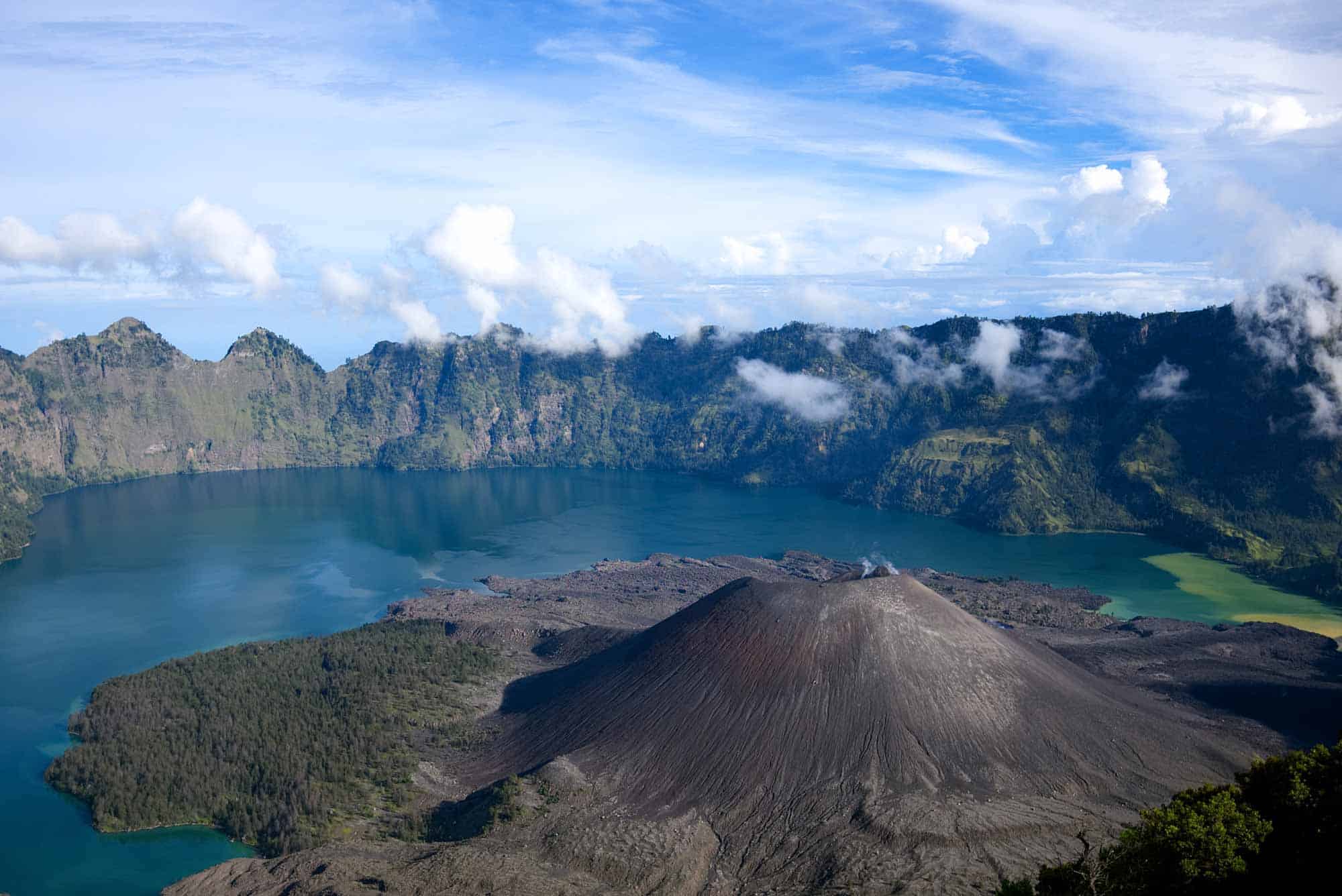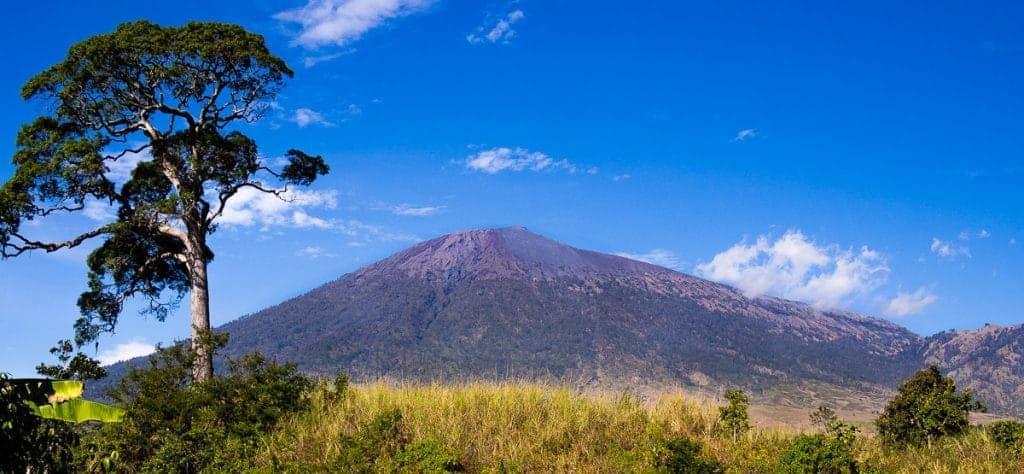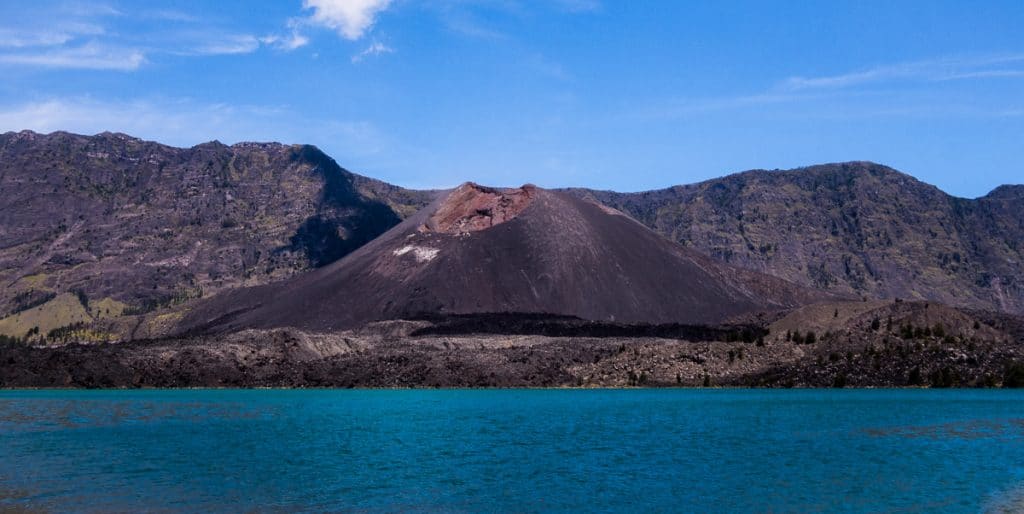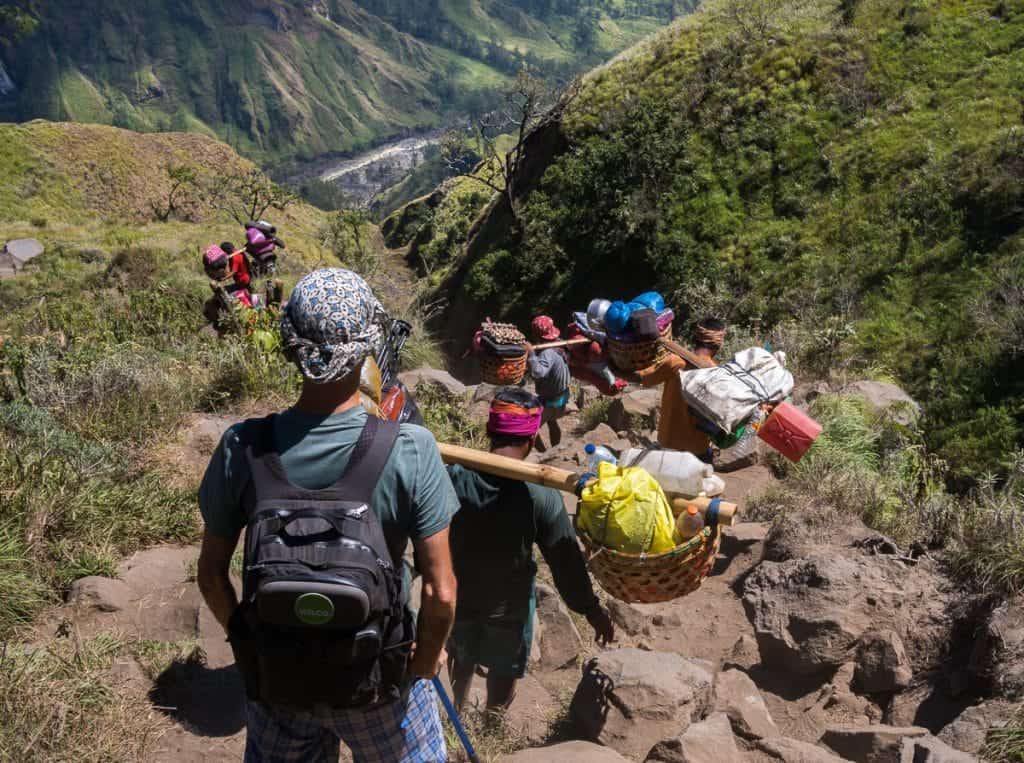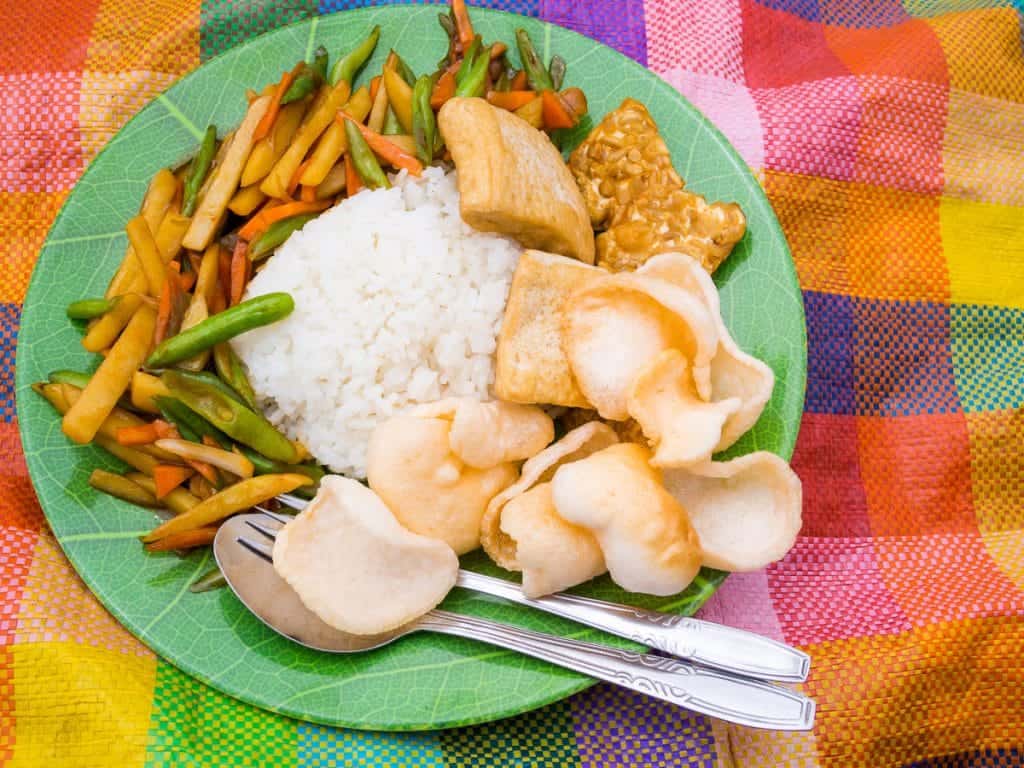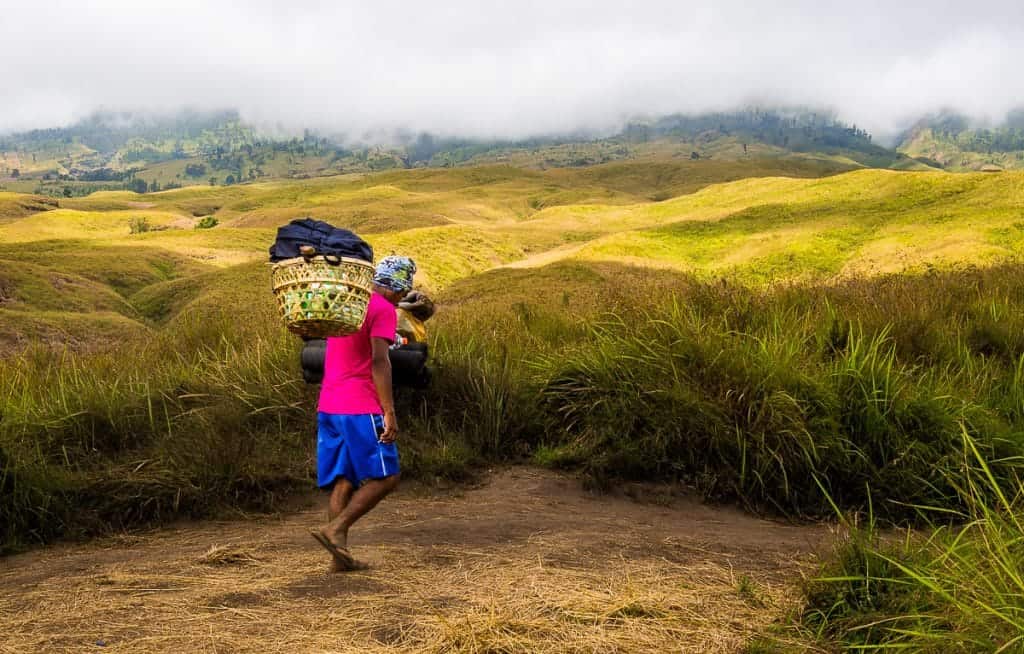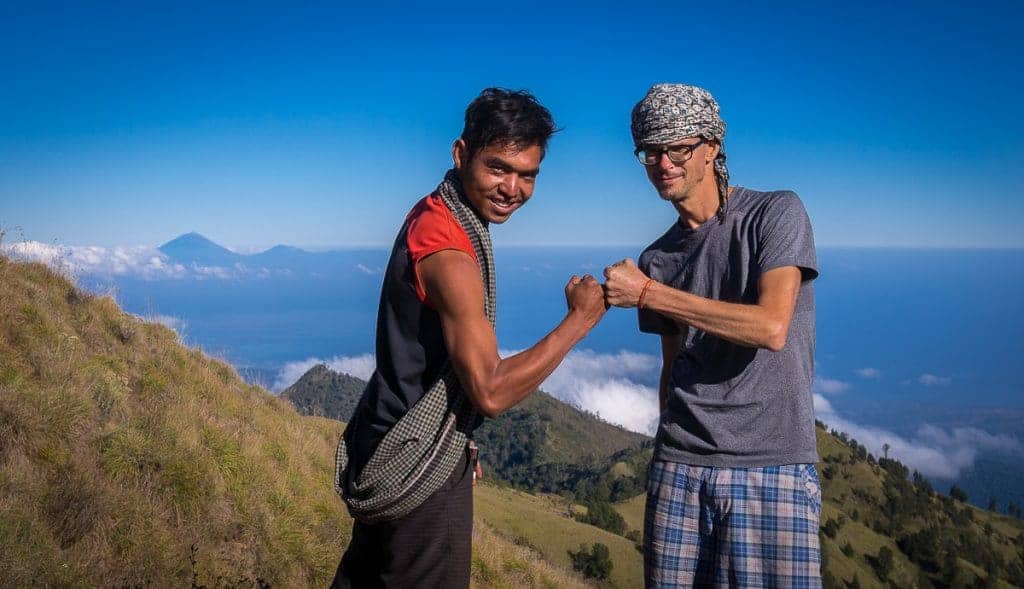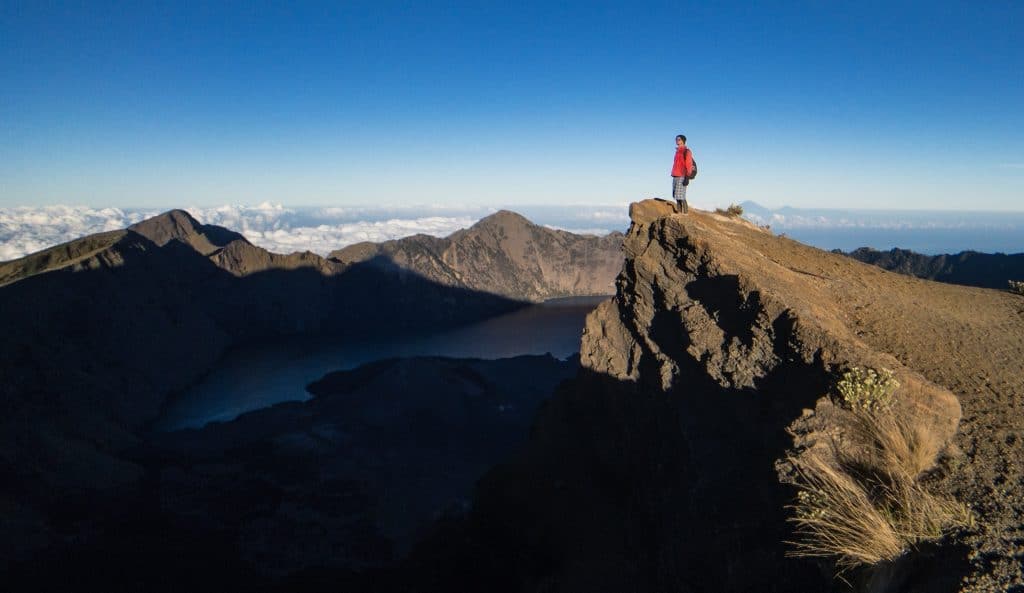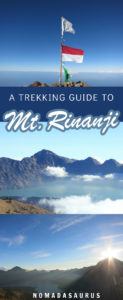There’s something deeply satisfying about standing on top of a mountain, watching the sun rise over the clouds after a tough hike.
Especially when that mountain is Mount Kinabalu; Malaysia’s highest peak and one of the most iconic climbs in Southeast Asia.
I’d wanted to tackle this beast for years, and when the chance came up to do it with two of our best mates, Hannah and Bertie, we locked it in.
We signed up with Amazing Borneo for their 2-day, 1-night summit and via ferrata package, and honestly, the entire experience was superb.
From start to finish, the adventure was smooth, fun, and a memorable challenge to tick off from the bucket list.
Here’s how our Mount Kinabalu climb went down.
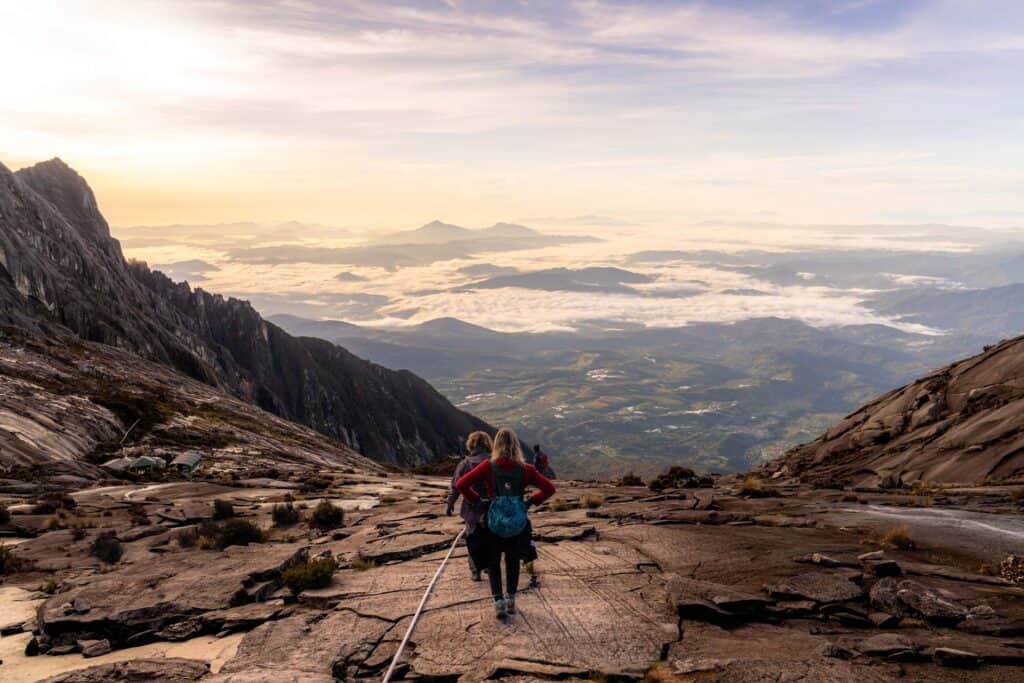
A Bit of Background: The Story of Mount Kinabalu
Before we get into the trip itself, a quick bit of history because this mountain isn’t just a pretty rock.
Mount Kinabalu stands at 4,095 metres (13,435 feet) and dominates the skyline of Sabah, in Malaysian Borneo.
It’s the tallest mountain between the Himalayas and New Guinea, and it holds deep spiritual significance for the local Kadazan-Dusun people.
The name is thought to come from “Aki Nabalu,” meaning “the revered place of the dead,” and according to tradition, it’s where spirits go to rest after passing on.
The first recorded ascent happened in 1851 by British administrator Hugh Low, who made it to the summit plateau (the peak is now named Low’s Peak after him).
But it wasn’t until 1888 that someone – zoologist John Whitehead – actually reached the highest point. Since then, Kinabalu has become a magnet for adventurers, nature lovers, and anyone chasing that feeling of standing on the roof of Borneo.
In 1964 Kinabalu Park was established to protect the area, and in 2000, it became Malaysia’s first UNESCO World Heritage Site thanks to its biodiversity. It is after all one of the most important ecological zones in the world.
So as you can see, it’s more than just a climb. It’s a journey into culture, nature, history and serious altitude.
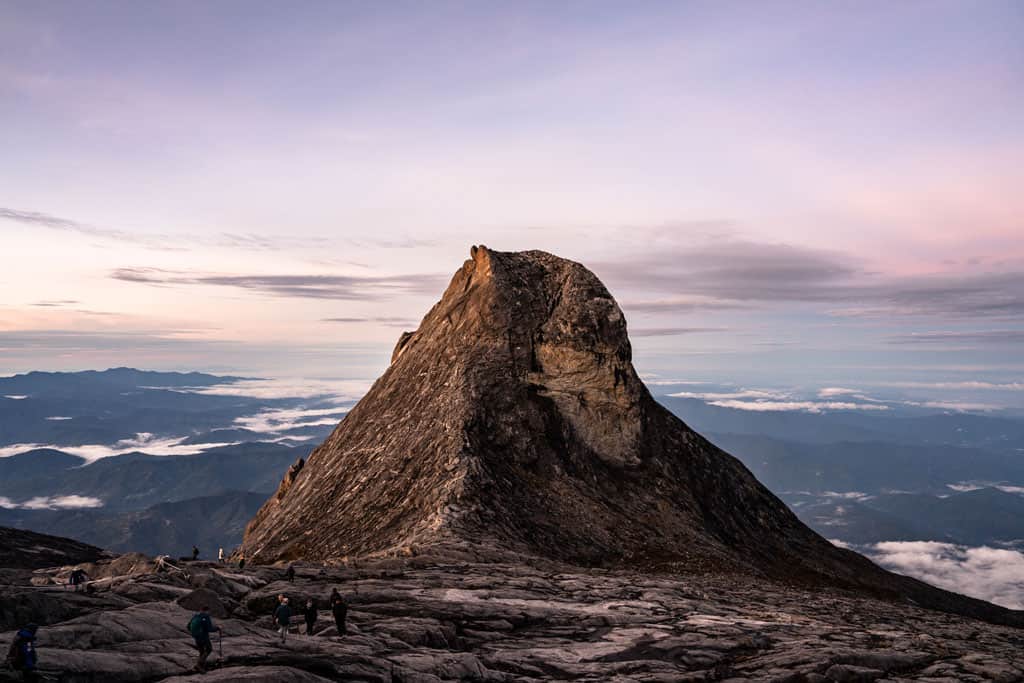
Day 1: Kota Kinabalu to Panalaban Base Camp
Our alarm went off at 5am in Kota Kinabalu.
We dragged ourselves out of bed, zipped up our packs, met the Amazing Borneo team downstairs with a comfortable private van, and within moments we were ready to roll.
Coffee in hand and packs in the back, we hit the road toward Kinabalu Park HQ.
The drive took about two hours, winding through jungle hills and past misty ridgelines. When we arrived we signed in, got our permits and tags, met our mountain guide, and did the final prep at Timpohon Gate (1,866m) – the starting point of the climb.
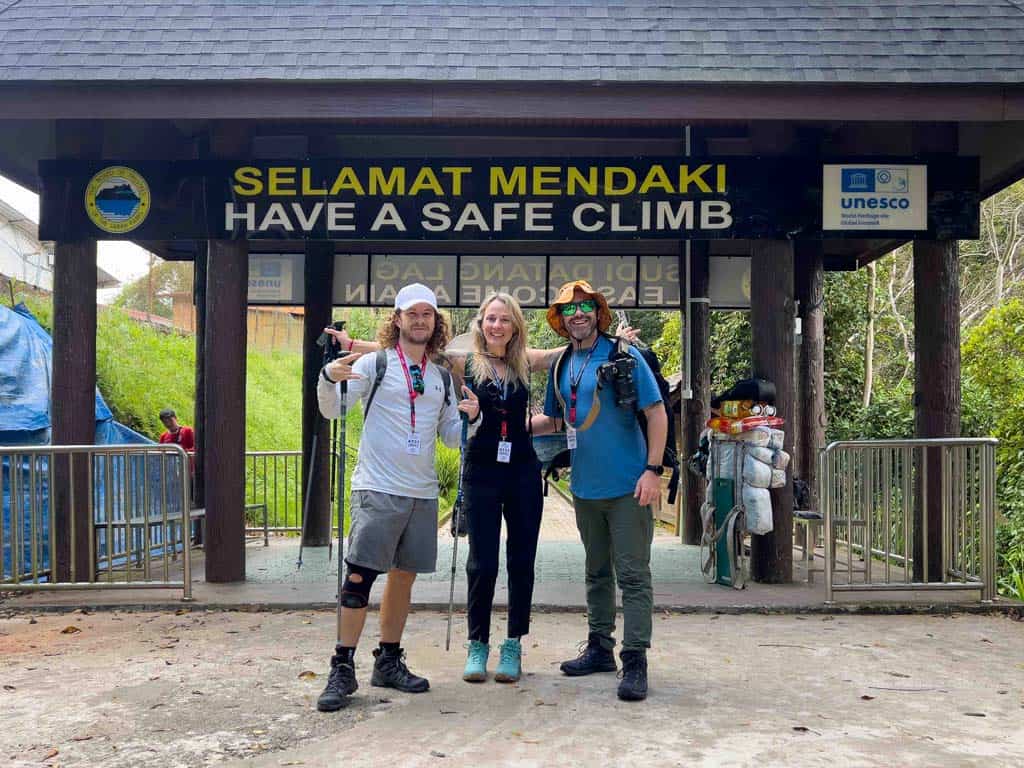
Now, I’ll be honest, we weren’t sure how tough it was going to be.
The blogs we had read and friends we spoke with said “it’s not technical,” but that doesn’t mean it’s easy.
Right from the start, it’s a constant slug uphill. You’re on well-built trails, mostly stone steps and packed dirt, but it’s relentless.
We kept a good pace, stopping to rest and hydrate every now and then at the break station.
READ MORE: Check out our best hiking tips!
The higher we climbed, the more the landscape changed, from thick rainforest to cloud forest, then open alpine scrub.
The air got cooler, the mist rolled in, and soon we began to get the real sense of being at altitude.
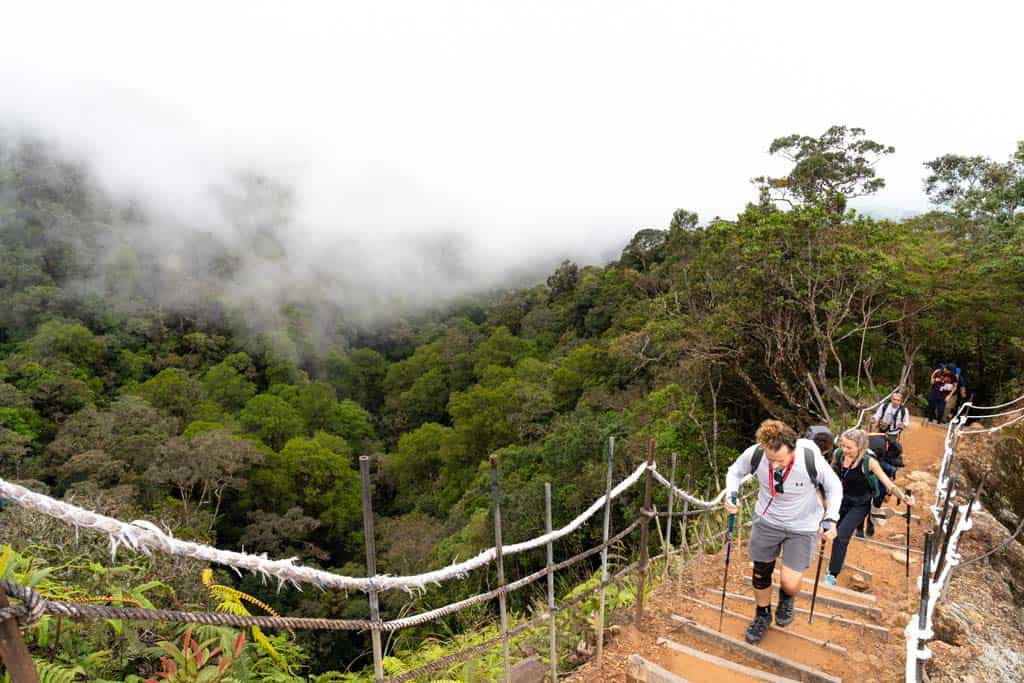
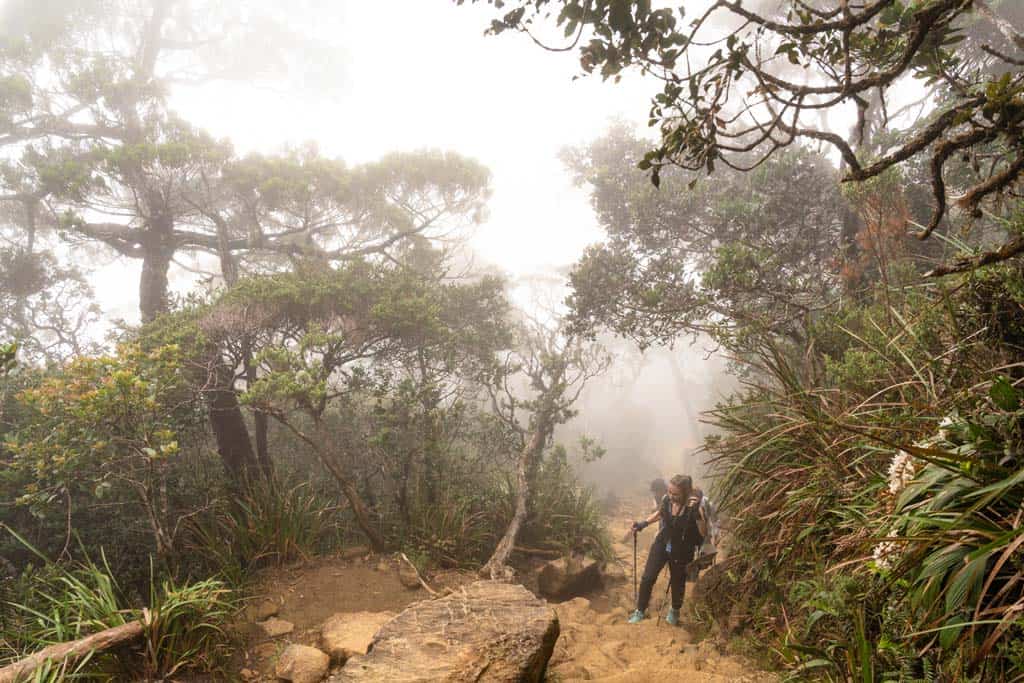
After about 4 hours, we arrived at Panalaban Base Camp (3,270m), where climbers sleep before the summit push.
The heated lodge is well-built and surprisingly comfortable. We had expected something extremely basic, but were quite impressed with its standards.
We checked into our dorm beds (which admittedly were jampacked with over 20 people to a room), had a quick hot shower, which we had not anticipated, changed into, clean dry clothes, and poured ourselves a cup of tea while waiting for the mandatory summit briefing.
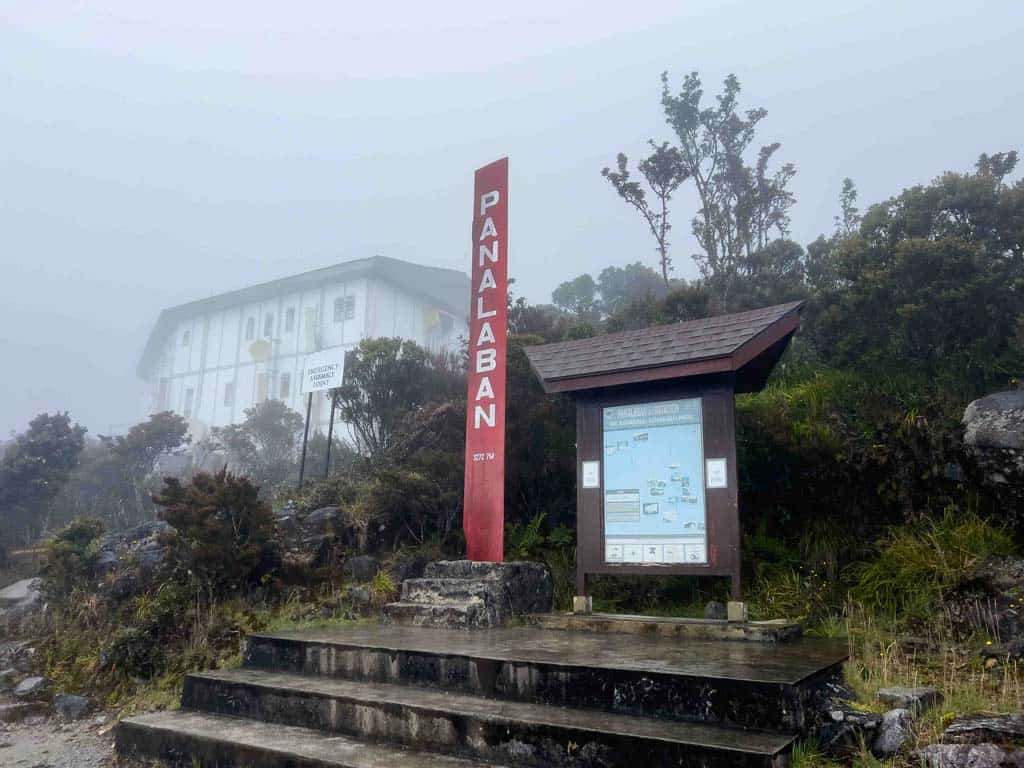

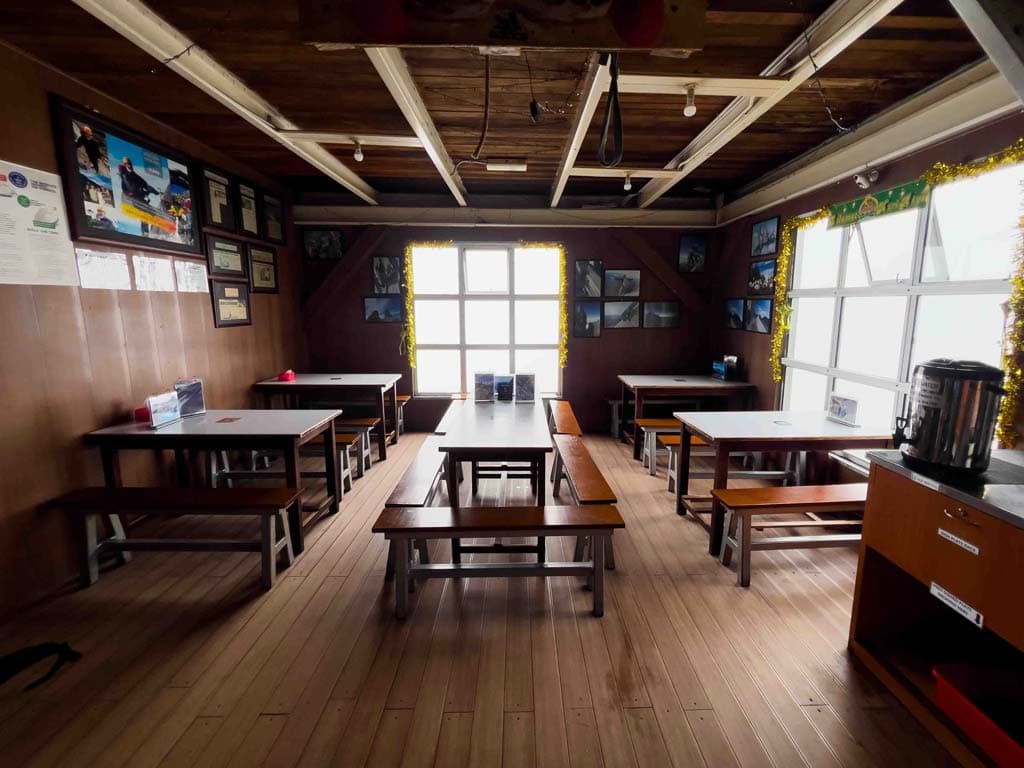
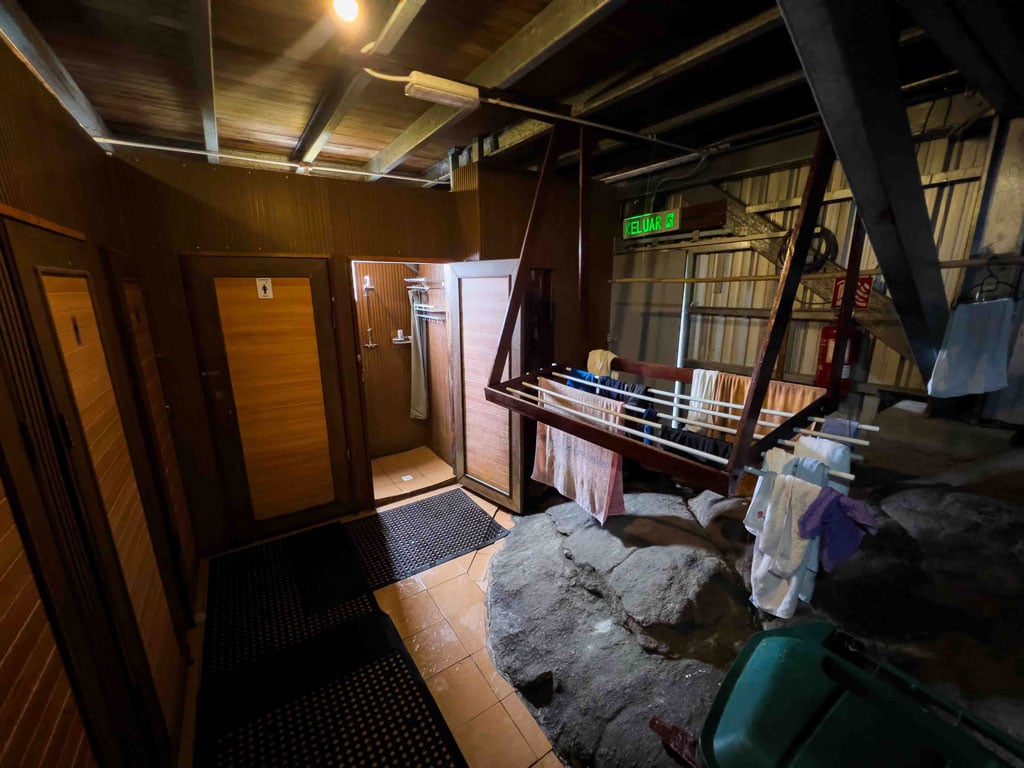
Once the rest of the hikers had made it to the lodge the mountain guides came and gave us a full breakdown on what the next morning would look like.
Afterwards we wandered down to the common room for a hot buffet dinner. Our timing was spot on and it started pouring just after we arrived. Huge drops hammering the roof, clouds swallowing the view and more impressively waterfalls poured down the huge granite rock faces.
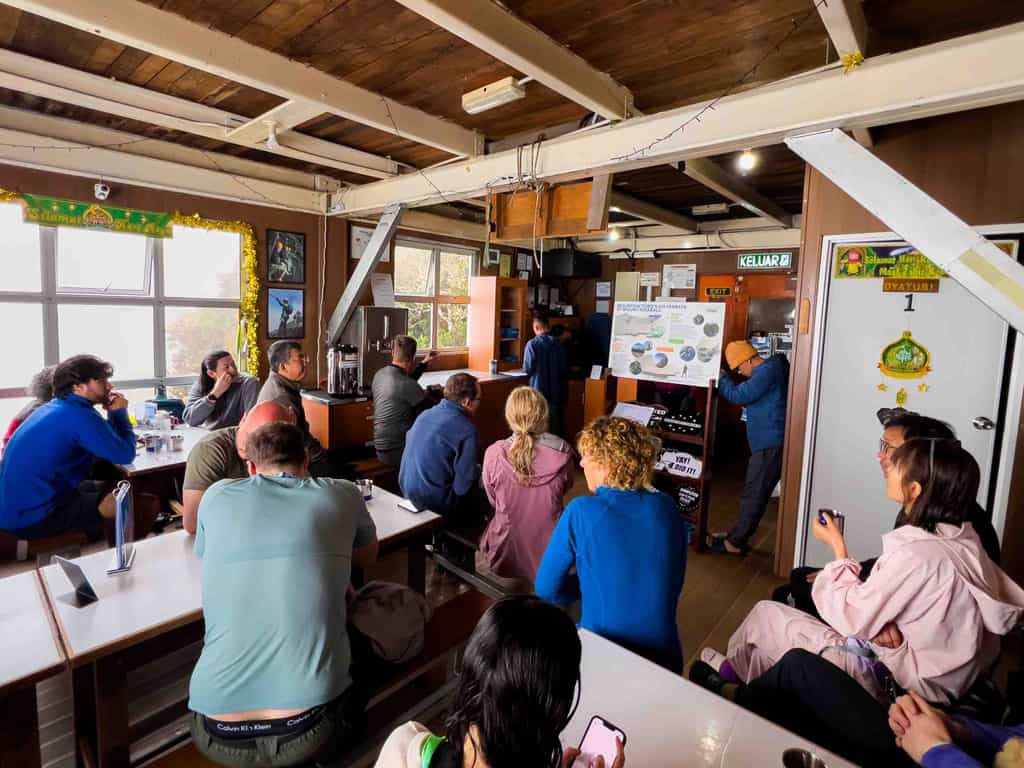
Once we realised the rain was settling in for a while we braved the downpour and headed back up to the lodge to prepare for bed.
We sat inside sipping tea, playing cards, and chatting with the other hikers.
There’s a real sense of camaraderie up there. Everyone’s a little nervous, a little excited, and a bit in awe of what they’re doing.
Each person has their own reasons for being up there. For some, it’s just another fun activity to do during their travels. For others it was a lifelong goal. And for quite a few, it was the most extreme thing they had ever done.
The mountain attracts some special people.
By 8pm we crawled into bed, with our alarms set for 2am.
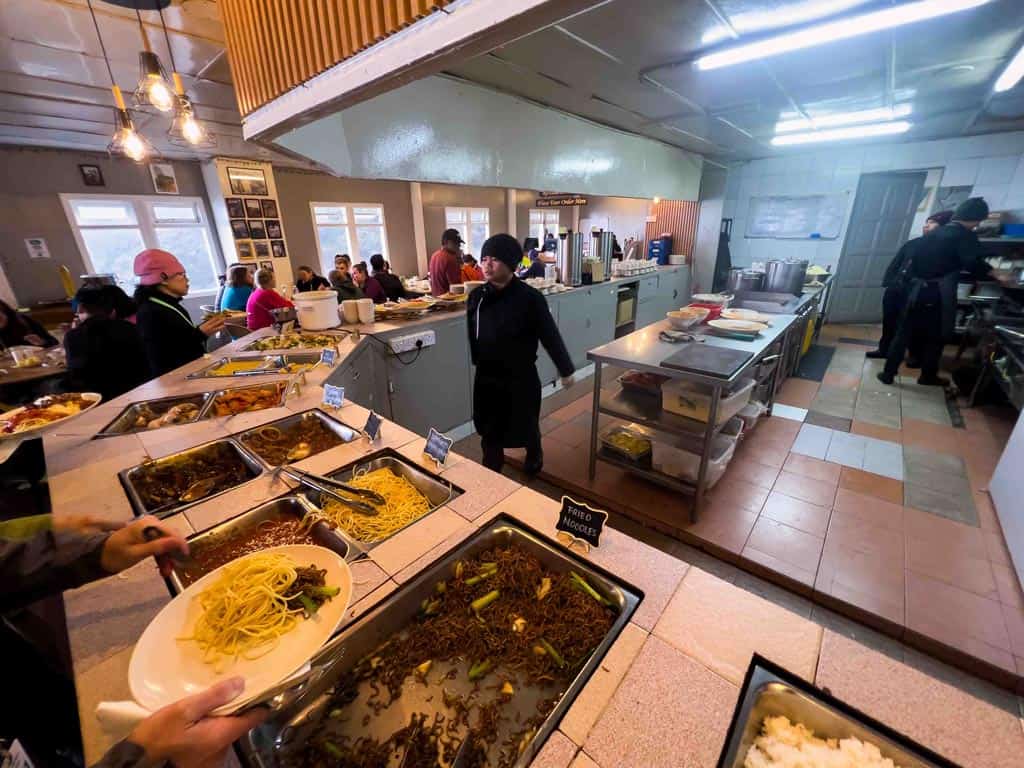
Day 2: The Summit Push
I crashed out hard and managed to sleep right through the night. The provided sleeping bags were very warm and I ended up just wearing underwear to ensure I didn’t overheat.
The room stirred and in the dark we pulled on our thermals, jackets, gloves, headlamps, made ourselves a quick coffee to wake up, and headed out into the cold dark morning.
The climb to the summit is about 2.7km from base camp, but don’t let the distance fool you. It’s steep, rocky, slippery in sections and challenging after a full day of hiking the day before.
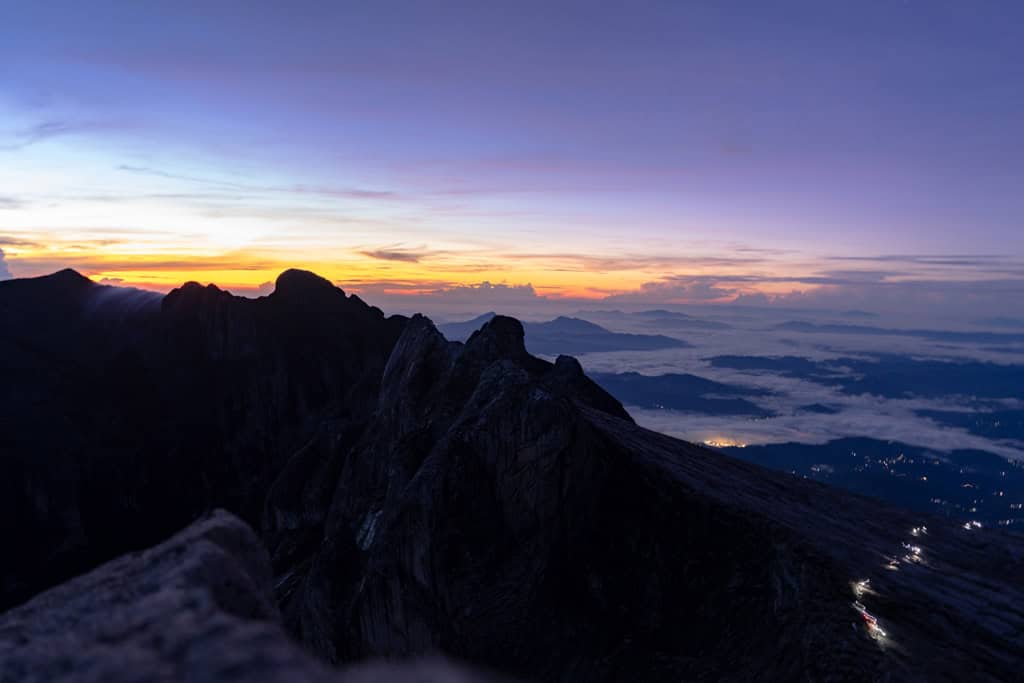
Guided by only the beams from our headlamps, we hiked through low trees before the trail quickly becomes more exposed.
You’re gripping ropes in some sections, climbing up smooth granite slabs with nothing but moonlight and headlamps to illuminate the way.
It’s not technical, nor dangerous if you pay attention, but it’s a grind.
One step at a time, slowly but surely.
The altitude kicks in hard above 3,500 metres. We were all feeling it in our breathing, but the Diamox we took seemed to help stave off any real symptoms.
We made good time and our guide soon suggested that we slow down and take more breaks in order to not spend the unnecessary time exposed on the summit.
With twilight approaching we reached Low’s Peak at 5am. 4,095 metres above sea level.
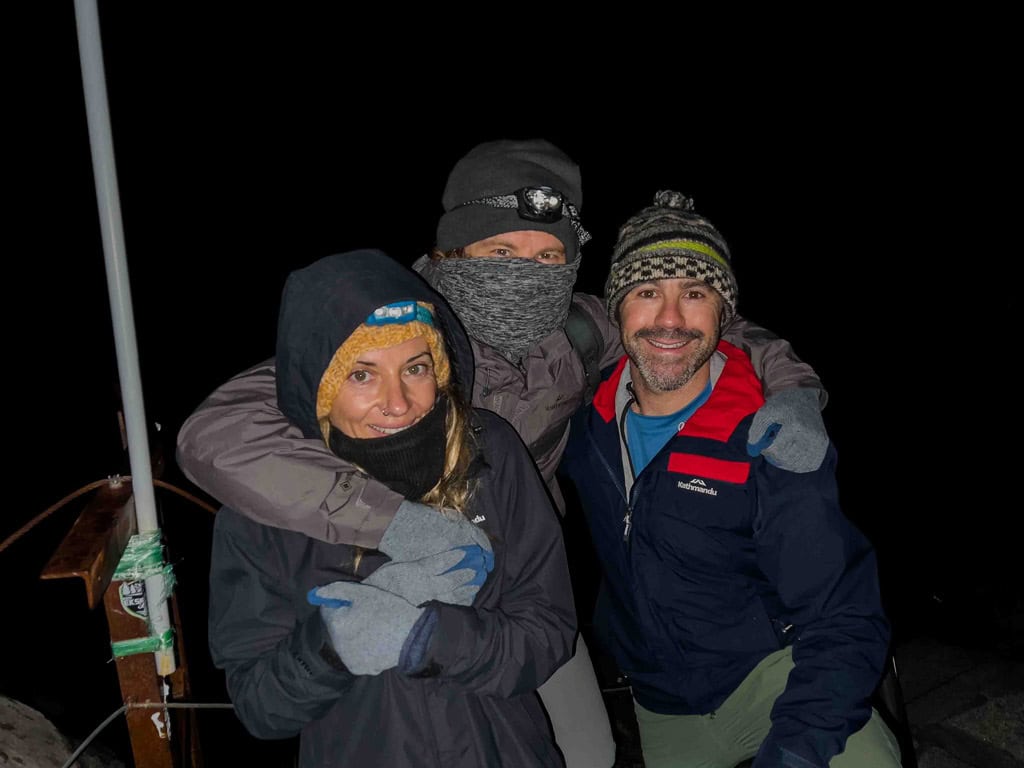
The temperature was below freezing, our fingers were numb and noses red from the cold.
But the feeling of standing on Borneo’s highest summit was truly remarkable.
It was still pitch black at the summit and we could just make out the lights of Kota Kinabalu in the distance.
Once we had taken our photos we wandered down from the tiny summit to a protected ledge that had more room to sit.
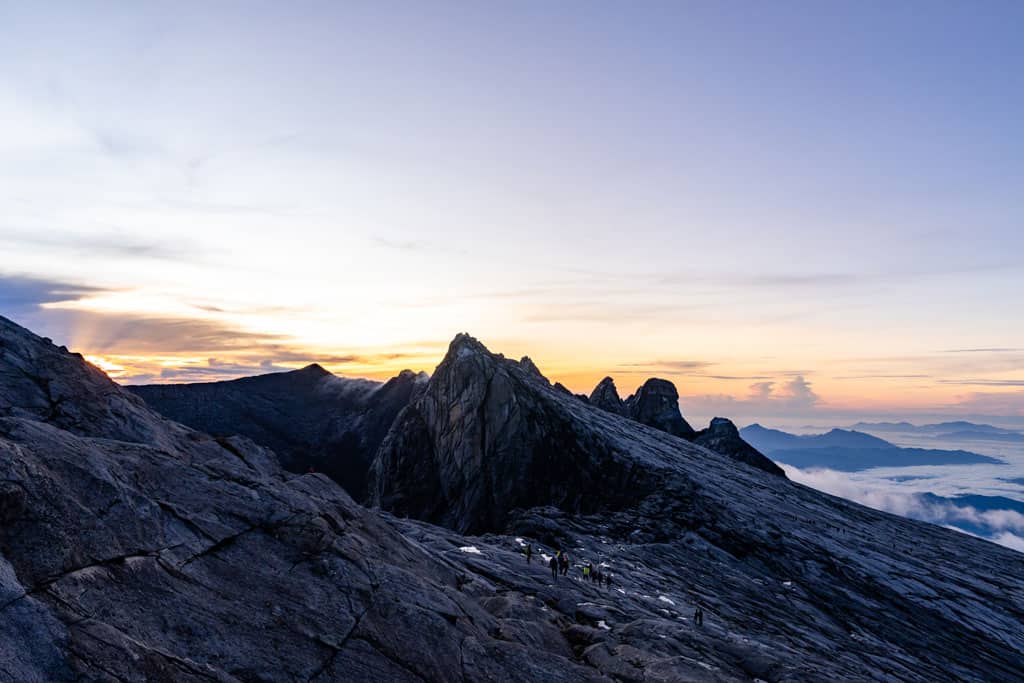
We wrapped ourselves in all of our layers, snacked on muesli bars and chocolate, and waited for the sun to rise above the magical island.
High above the clouds we wateched the sky morph from pitch black to golden pink. The sky didn’t explode in a kaleidoscope of colour like we had hoped, but that didn’t matter.
Watching the sunrise from the highest point in Borneo with two of my best friends made it one of the most beautiful mornings I’ve ever had.
We stood there, hugged, took some photos, and soaked it all in. You don’t get many moments like that in life.
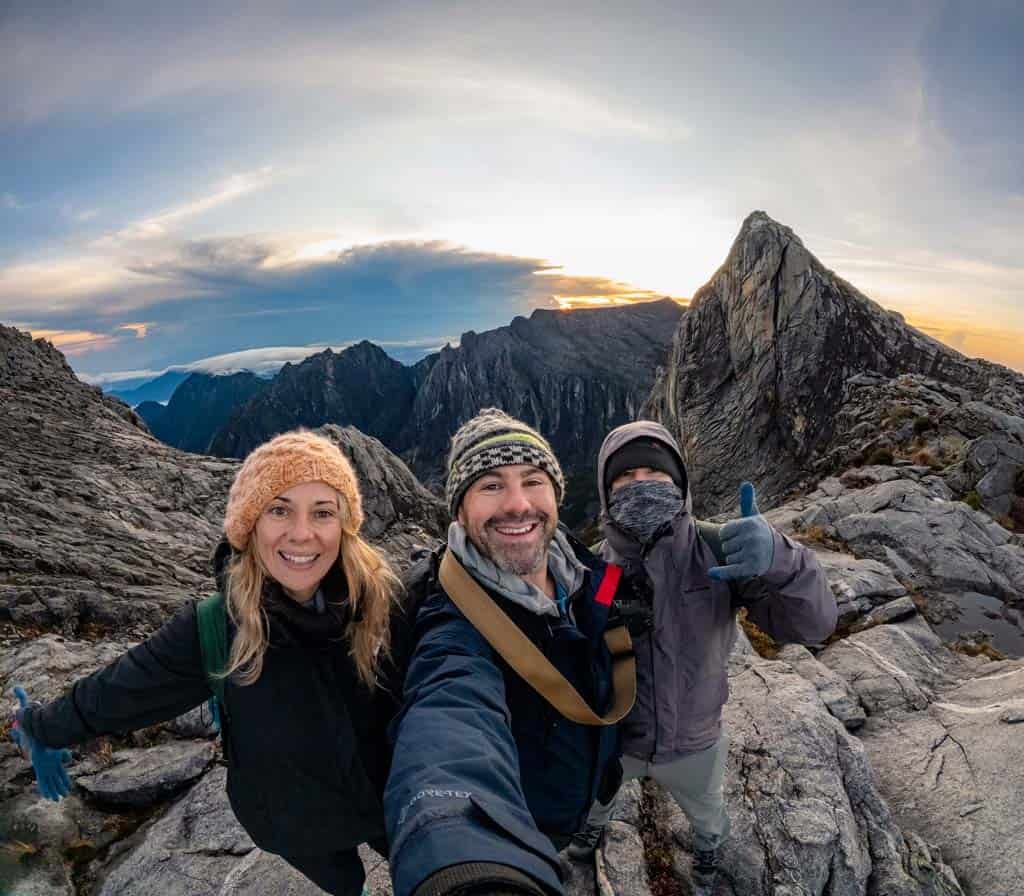
The Descent and the Via Ferrata
Before the sun rose too high in the sky it was time to leave the summit and make our way back down the mountain.
From here there are 3 options that need to be pre-booked.
Either head straight back down to camp and then onwards to the base, or take one of the two Via Ferratas to descend.
A via ferrata is a protected climbing route with steel cables, rungs, and suspension bridges built into the mountain.
You clip in with a harness and two carabiners and make your way across the cliffs. It’s part scrambling, part adventure course.
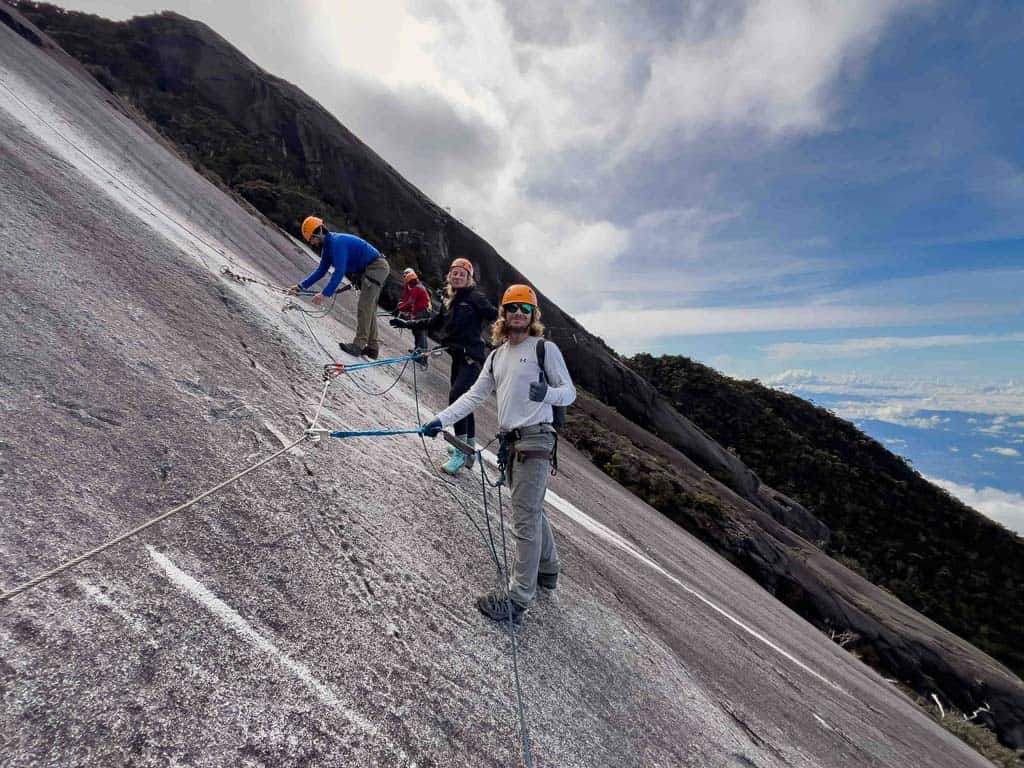
We signed up for the “Walk the Torq” which is the shorter of the two options offered, as the full Via Ferrata was fully booked.
But don’t let that fool you – it’s still a tonne of fun.
We left the track and met our Via Ferrata guides near the ranger’s hut. After a short safety briefing we clipped in and started our descent across sheer granite walls with nothing but 1,000 metres of air beneath us.
It was a fantastic experience. Enough of a rush to get the adrenaline pumping but safe and accessible for most people with moderate fitness.
The views were next-level. We were literally walking across a cliff with sweeping views of the jungle valleys below.
It took about 2 hours to complete the via ferrata, and then it was time to hike back to the Panalaban lodge to collect the rest of our gear and then navigate all the way back down to Timpohon Gate.
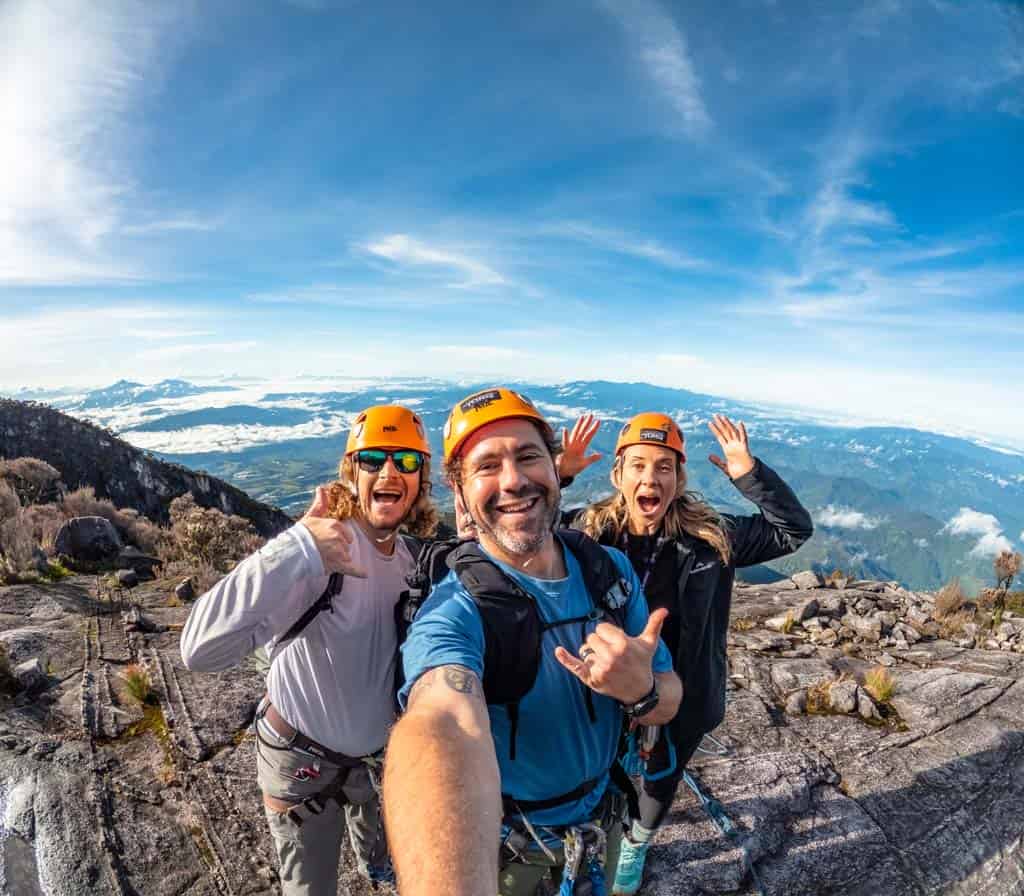
The descent is relentless. Endless steps and switchbacks pounding your calves and knees for hours.
We were tired, sore, and soaked in sweat and rain by the end, but still buzzing from the experience.
At around 1pm we arrived to the gate and met our transfer. We were shutled back to the main base camp and then jumped in our private van to leave the mountain and enjoy the ride back to Kota Kinabalu.
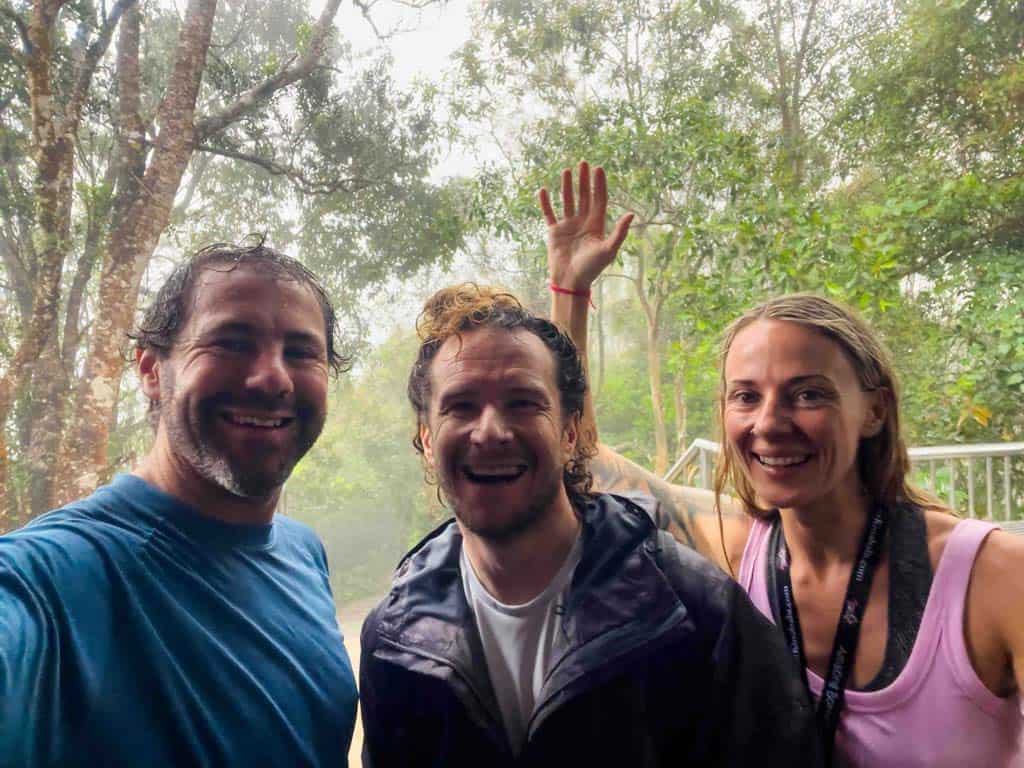
Final Thoughts
Climbing Mount Kinabalu isn’t just a hike, it’s a full-blown adventure. The altitude, the early morning summit push, the changing ecosystems, the cultural significance, the camaraderie with fellow hikers – it all adds up to something truly special.
Amazing Borneo were fantastic throughout the whole experience. Professional, friendly, organised, and passionate about what they do.
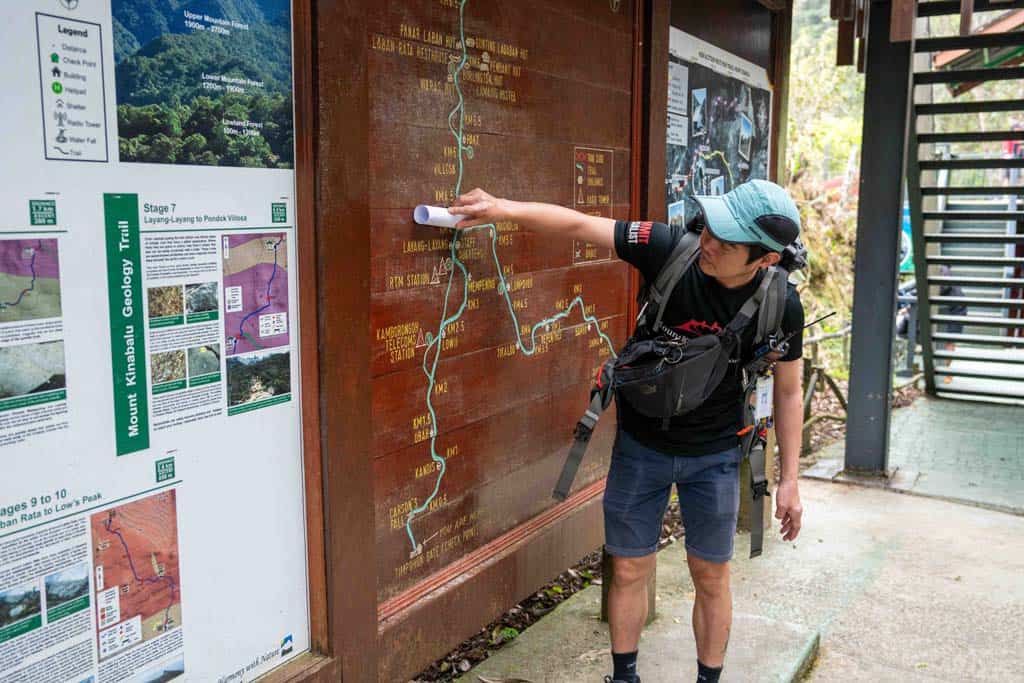
Our guide was knowledgeable and supportive, our driver was safe and on time, and the logistics all ran like clockwork.
Once we had made our booking all we had to worry about was the early wake up call on that first day, and they looked after the rest.
If you’re thinking about doing this climb, do it. Book early, train, pack smart, and go with an open mind. You’ll come down with sore legs and a big smile.
And trust me – the sunrise at the summit is worth every single step.
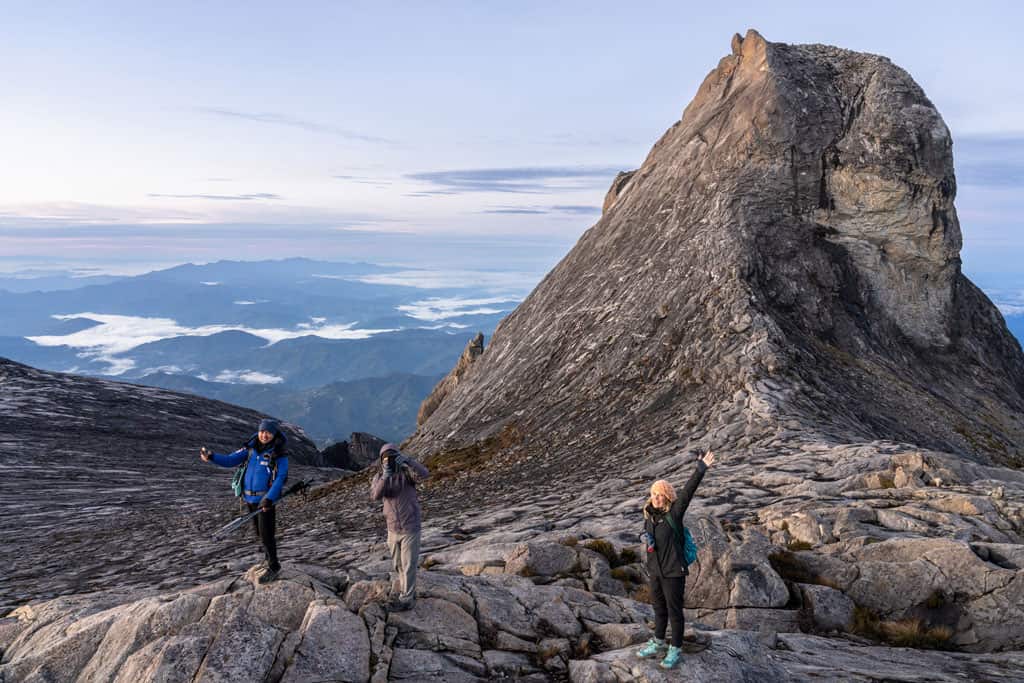
Things to Know Before Climbing Mount Kinabalu
Planning to climb Mount Kinabalu? Whether you’re an experienced trekker or this is your first big mountain, there are a few essential things you need to know before lacing up your boots and heading into the clouds.
From when to go to what to pack, this guide will help you prepare for an unforgettable adventure.

1. How to Book Your Climb
Unlike many other hikes around the world, you can’t just show up at Mount Kinabalu and start walking. The mountain is tightly regulated with daily climbing permits capped to protect the environment and ensure safety.
You must book through an approved tour operator, and we highly recommend Amazing Borneo. They handle everything: permits, transport, meals, accommodation, guides, and even the optional via ferrata.
Book early: Ideally 2–3 months in advance, or longer during peak seasons (April to August). The climb often sells out quickly, especially with fewer permits available post-pandemic.
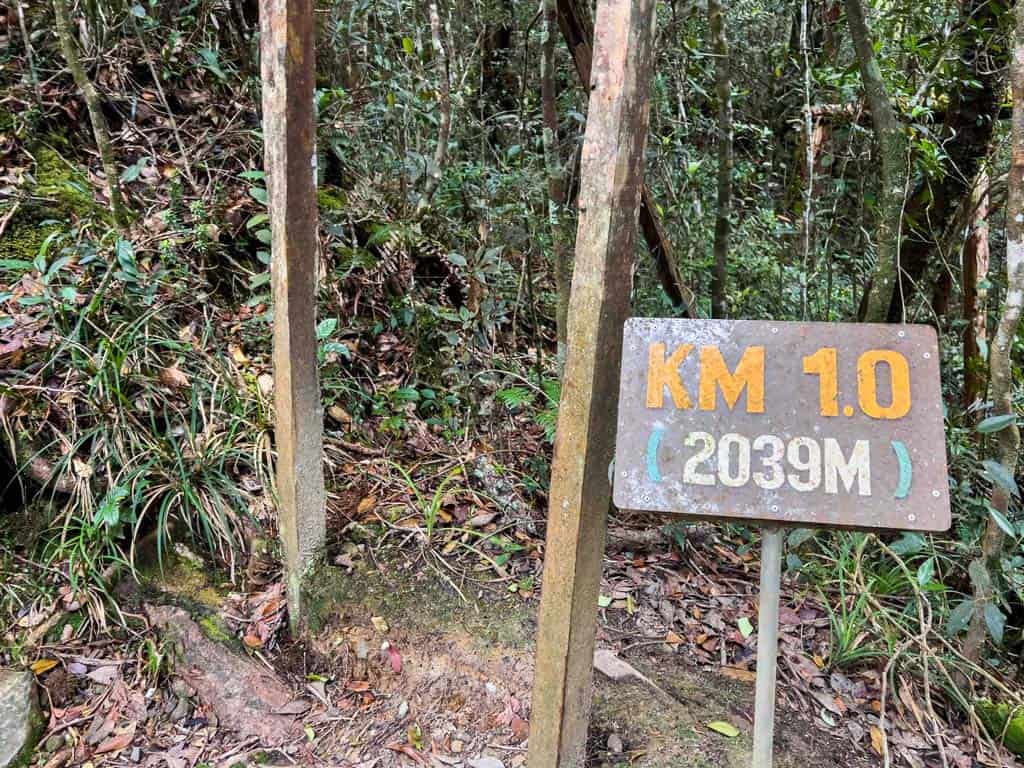
2. Best Time of Year to Climb
Mount Kinabalu can be climbed year-round, but March to September is considered the best window. This is the dry season in Sabah, and you’ll have the best chance of clear skies and safe summit conditions.
October to January is wetter, and while it’s still possible to hike, you’ll face more rain, slippery trails, and a higher chance of summit closure due to storms.
Always check the weather forecast before your trek, but remember: on the mountain, conditions change fast. It can be sunny at base camp and stormy at the summit.
3. How Hard Is the Hike?
Mount Kinabalu is not a technical climb, but it is tough. You’ll ascend over 2,200 metres in elevation in just under 9km, and altitude affects everyone differently.
Expect sore legs, short breath, and a test of endurance. But if you’re moderately fit and pace yourself, it’s totally achievable. The key is mental resilience and steady movement, not speed.
The final push to the summit involves some scrambling over granite rock with ropes for support. It’s safe, but you’ll feel it.
In the days that follow you’ll likely be walking funny. Stairs will suck, getting out of bed will be slow and you’ll have a funny shuffle as you bounce around the rest of Borneo.
We highly recommend giving yourelf a few relaxing days after the climb to recover.
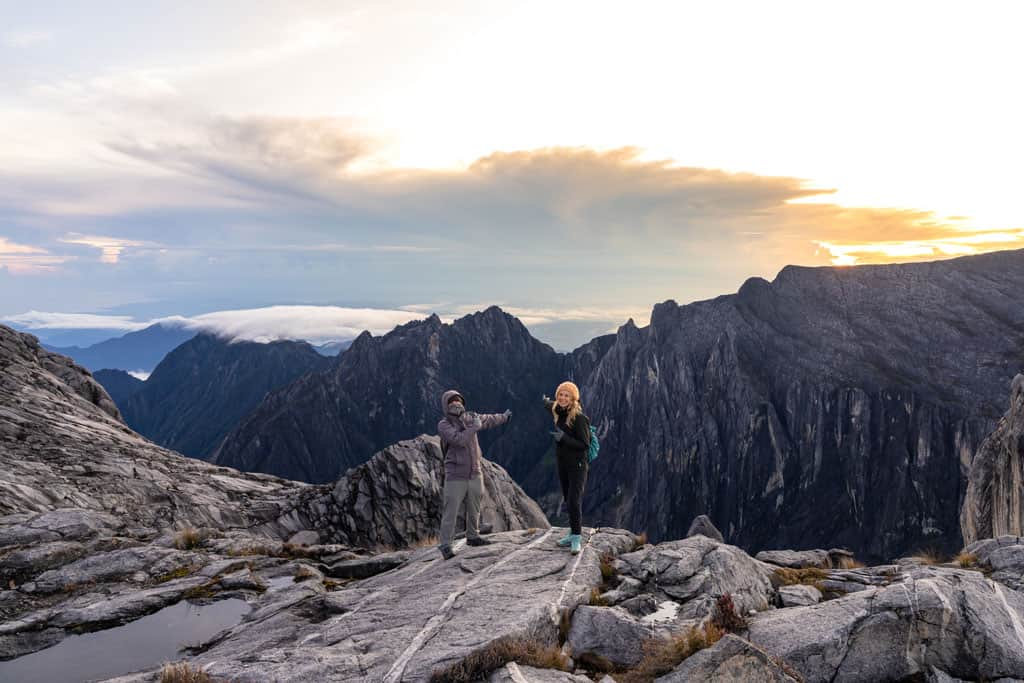
4. What to Pack
Packing right is essential, especially since you’ll be going from steamy lowlands to freezing altitudes.
Here’s what you’ll need:
Essentials:
Clothing:
- Moisture-wicking base layers
- Fleece or insulated jacket
- Waterproof jacket and pants
- Gloves and beanie
- Extra socks and underwear
- Comfortable clothes for sleeping at base camp
Other useful items:
- Altitude sickness tablets (we took Diamox bought in Kota Kinabalu -consult your doctor)
- Sunscreen and lip balm
- Toiletries (toothbrush, wet wipes, etc.)
- Cash for tipping guides and buying snacks at camp
- Camera or phone with a power bank
Your operator may carry a porter bag or store overnight gear at base camp, but you’ll need to carry your own daypack during the hike.
You can also hire a porter for an additional fee.
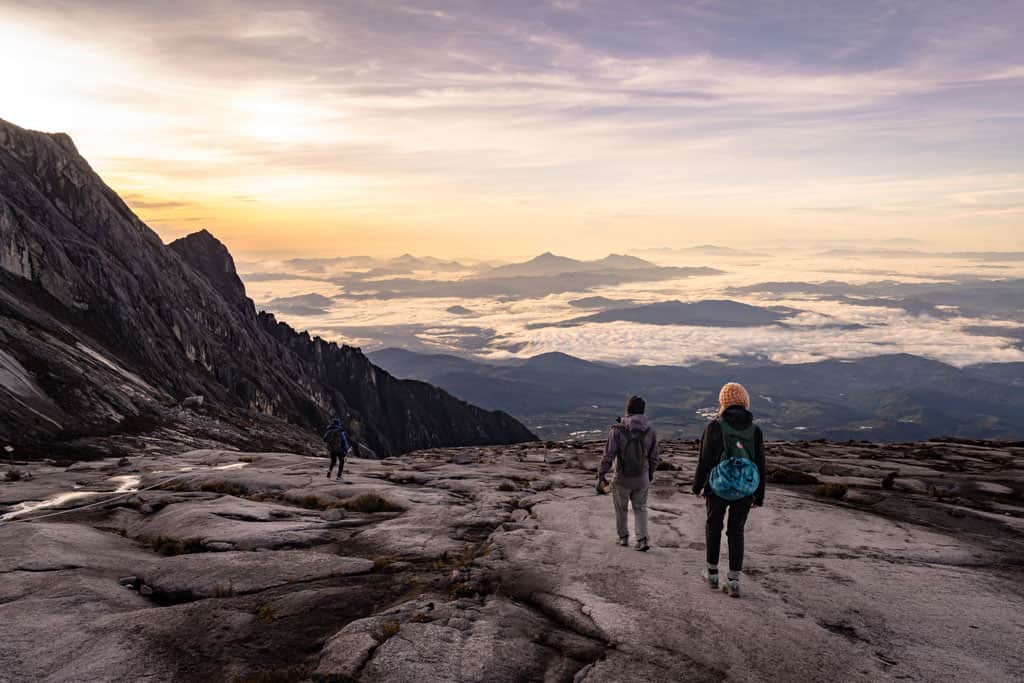
5. What’s Included in a Tour
When you book with a reputable company like Amazing Borneo, you’ll typically get:
- Return transport from Kota Kinabalu (we opted for the package with the private van and it was well worth it)
- Climbing permit and park entrance fees
- Certified mountain guide
- Meals (dinner and breakfast, as well as a lunch at base camp)
- Accommodation at Panalaban Base Camp (shared dorms or private rooms)
- Certificate of completion
- Optional via ferrata experience (must be booked separately)
All meals are cooked at altitude and are hearty. Think rice, noodles, eggs, vegetables, and chicken. Dietary requirements can usually be catered for with notice.
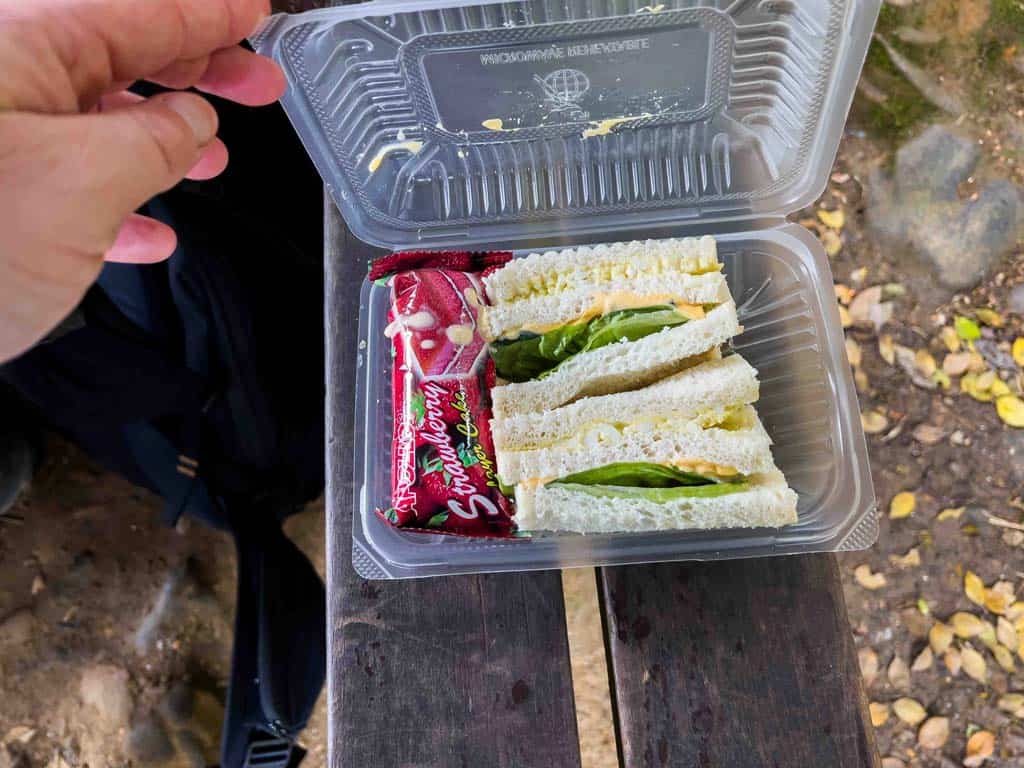
6. Altitude: How It Affects You
Mount Kinabalu is just over 4,000m high, and altitude sickness is a real risk. You’ll be sleeping at 3,270m and summiting early the next morning.
Symptoms can include headache, nausea, fatigue, dizziness, and shortness of breath. Most people are fine if they hydrate, pace themselves, and don’t overexert.
We took Diamox (acetazolamide) as a precaution and had no issues. You should speak with your doctor before your trip to see if it’s right for you.
7. The Via Ferrata: Should You Do It?
The via ferrata is a highlight of the Mount Kinabalu experience, and the highest one in the world! You clip into a series of steel cables and climb along cliff edges with incredible views.
There are two options:
- Walk the Torq: Easier, shorter, and perfect for beginners.
- Low’s Peak Circuit: Longer, more exposed, and better for confident adventurers.
You must book the via ferrata when you reserve your climb. You can’t add it on last-minute, trust me I tried to upgrade to Low’s Peak Circuit and couldn’t.
Safety briefings happen the day before at Panalaban, and you need to be at the summit by a certain time to participate, so don’t dawdle in the morning.
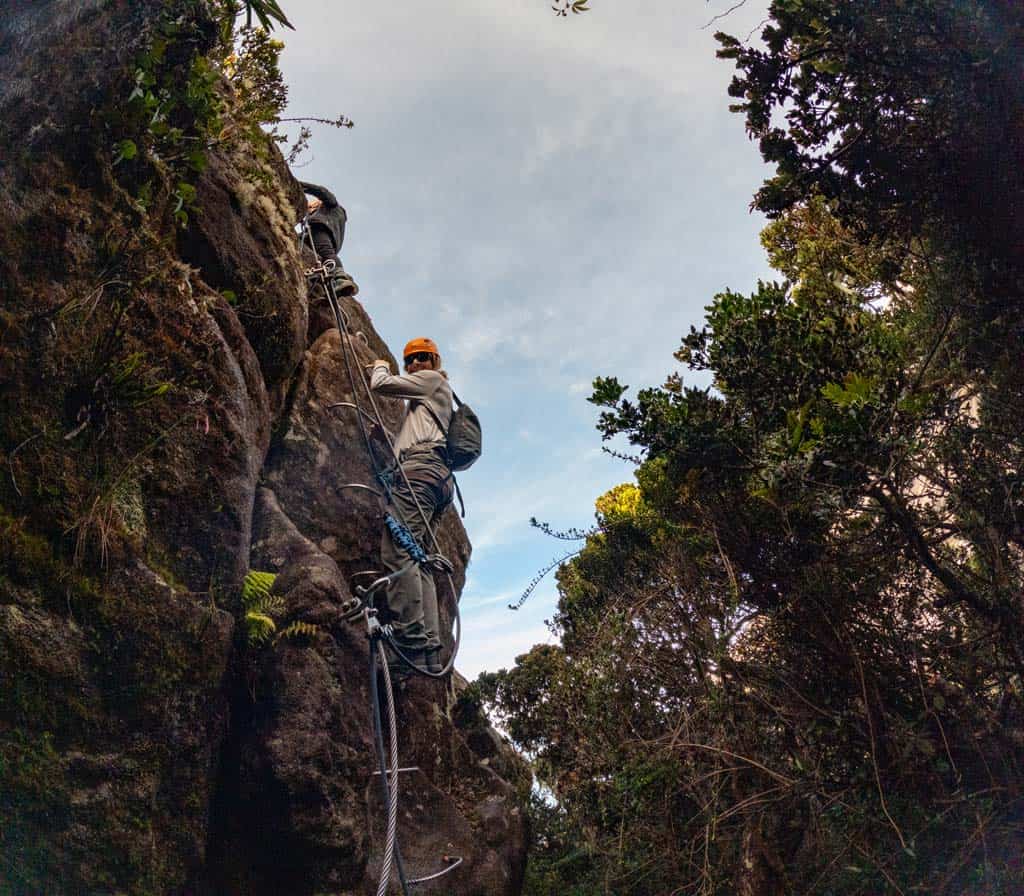
8. Tips for a Successful Climb
- Train beforehand: You don’t need to be a marathon runner, but regular cardio and leg strength training will help.
- Take your time: Go slow and steady. The guides are used to all fitness levels.
- Layer up: It’s hot at the bottom and freezing at the top. Layers are your best friend and you’ll like strip down and dress up every hour.
- Start early: The summit push starts at 2am to catch the sunrise—get to bed early and pack everything the night before.
- Respect the mountain: It’s a sacred place for locals. Don’t litter, don’t blast music, and keep your voice down.
9. Staying in Kota Kinabalu
Most people base themselves in Kota Kinabalu (KK) before and after the hike. It’s a relaxed seaside city with good restaurants, a buzzing night market, and affordable accommodation.
We recommend arriving in KK at least a day before your climb to get organised, and spending another night after your descent to rest and recover.
Final Word
Climbing Mount Kinabalu is one of the best adventures in Southeast Asia. It’s tough, stunning, and unforgettable.
Go in with the right mindset, book with a trusted operator like Amazing Borneo, and prepare properly – and you’ll come away with sore legs, big smiles, and a sunrise memory you’ll never forget.

DISCLAIMER: Some of the links in this article are affiliate links, which means if you book accommodation, tours or buy a product, we will receive a small commission at no extra cost to you. These commissions help us keep creating more free travel content to help people plan their holidays and adventures. We only recommend the best accommodations, tours and products that ourselves or our fantastic editorial team have personally experienced, and regularly review these. Thanks for your support, kind friend!
![Climbing Mount Kinabalu – The Ultimate Trekking Guide [2025]](https://farasar.ir/wp-content/uploads/2025/07/Mount-Kinabalu-Climb-Trek-Guide-Featured-Image.jpg)
